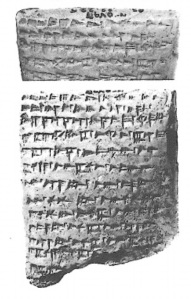Things have been a little quiet round here recently. Sorry about that – term kind of got in the way. But hopefully now things aren’t quite so busy I’ll be able to get a few things written, starting now.
Let’s talk about mermaids, shall we? Well, not just mermaids but mermen and fish-people of all stripes. I’ve been meaning to write something on this for a while, but a discussion on Twitter this morning about Dagan prompted me to actually get started. Dagan has often been seen as a fish-deity because in Hebrew dag means fish. These Mesopotamian images of mermen and priests dressed as fish are often linked with Dagan.





 It’s time for another under-appreciated ancient monster from antiquity – or rather multiple monsters – because today we’re looking at the Devourers (ʾaklm), demons from Ugaritian mythology who faced off against Baʿal Hadad, the storm-god and patron deity of the city. Unfortunately no pictures of the Devourers exist, so I’ve had to make do with this image of Baʿal himself, on a stele from Ugarit and now in the Louvre.
It’s time for another under-appreciated ancient monster from antiquity – or rather multiple monsters – because today we’re looking at the Devourers (ʾaklm), demons from Ugaritian mythology who faced off against Baʿal Hadad, the storm-god and patron deity of the city. Unfortunately no pictures of the Devourers exist, so I’ve had to make do with this image of Baʿal himself, on a stele from Ugarit and now in the Louvre.

 I wrote recently about the excellent Lovecraftian board game
I wrote recently about the excellent Lovecraftian board game 